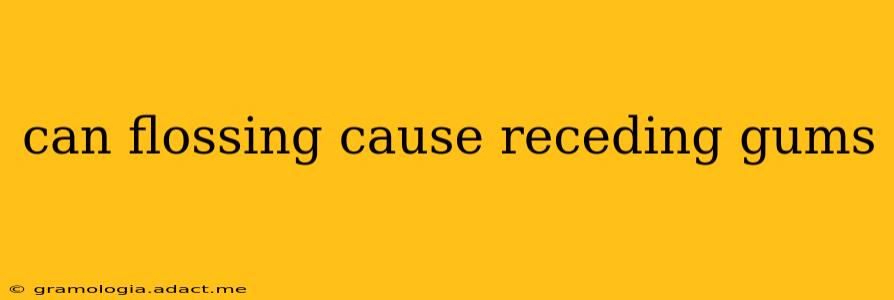Can Flossing Cause Receding Gums? The Truth About Flossing and Gum Health
The question of whether flossing can cause receding gums is a complex one, often fueled by anecdotal evidence and misconceptions. While proper flossing is crucial for oral hygiene, aggressive or incorrect flossing techniques can contribute to gum recession. Let's delve into the details to understand the relationship between flossing and gum health.
The Short Answer: No, flossing itself doesn't directly cause receding gums. However, improper flossing techniques can contribute to gum recession and other oral health problems.
How Proper Flossing Benefits Gum Health:
Before addressing the concerns, it's vital to highlight the significant benefits of flossing. Flossing is an essential part of maintaining healthy gums because it:
- Removes Plaque and Food Particles: Flossing reaches areas your toothbrush can't, effectively removing plaque and food particles that accumulate between teeth. These particles, if left undisturbed, can contribute to gingivitis (gum inflammation) and periodontal disease (gum disease).
- Prevents Gum Inflammation: By reducing plaque buildup, flossing helps prevent gingivitis, characterized by red, swollen, and bleeding gums. Addressing gingivitis early is crucial to prevent it from progressing to more severe periodontal disease.
- Reduces Bad Breath: Food particles trapped between teeth contribute to bad breath. Flossing eliminates these particles, leading to fresher breath.
- Supports Overall Oral Health: Maintaining healthy gums through proper flossing is vital for overall oral health, as gum disease can have serious implications for overall well-being.
How Improper Flossing Can Contribute to Receding Gums:
The risk of gum recession arises not from the act of flossing itself, but from how it's performed. Aggressive flossing techniques can damage the gum tissue, leading to recession. Here's how:
- Snapping the Floss: Instead of gently guiding the floss between teeth, aggressively snapping the floss can injure the gum tissue, causing it to recede over time.
- Using Excessive Force: Applying too much pressure while flossing can also damage the delicate gum tissue, leading to recession. The floss should gently hug the tooth's surface, not aggressively scrub against the gums.
- Incorrect Flossing Technique: Using the wrong technique, such as sawing the floss back and forth, can also lead to gum damage. The correct technique involves a gentle "C" shape around each tooth, carefully moving the floss up and down.
What are the signs of improper flossing?
Several signs indicate you might be flossing incorrectly:
- Bleeding gums: While some bleeding is normal when first starting to floss regularly, persistent bleeding after weeks of consistent flossing suggests an issue.
- Pain or discomfort: Flossing shouldn't be painful. Discomfort signals that you're using too much force or an incorrect technique.
- Receding gums: Noticeably receding gums are a clear sign that something is wrong.
What should I do if I think I'm flossing incorrectly?
If you experience any of these signs, it's crucial to consult your dentist or hygienist. They can demonstrate the correct flossing technique, address any gum problems, and help you develop a healthy oral hygiene routine. They can also rule out other potential causes of receding gums, such as genetics, hormonal changes, or underlying medical conditions.
Are there alternatives to traditional flossing?
Yes, several alternatives exist, including interdental brushes, water flossers (irrigators), and floss picks. Your dentist can help you determine which option is best suited to your individual needs and oral health condition.
By using the correct technique and avoiding aggressive flossing, you can reap the numerous benefits of flossing while minimizing the risk of gum recession. Remember, maintaining good oral hygiene is a collaborative effort between you and your dental professional. Regular check-ups and professional cleanings are crucial for preventing and addressing any oral health concerns.
